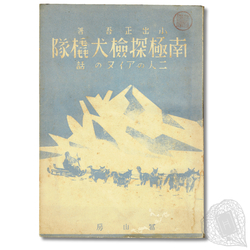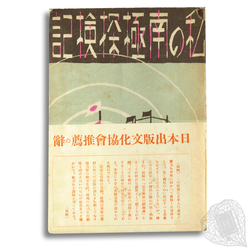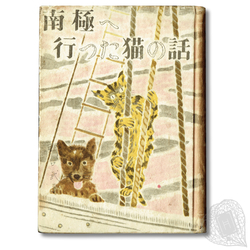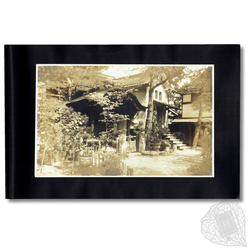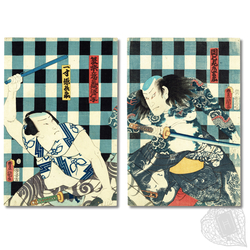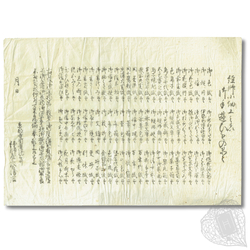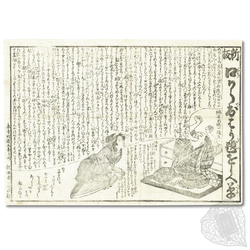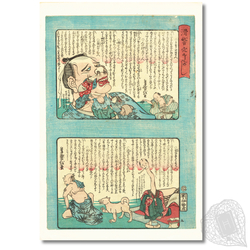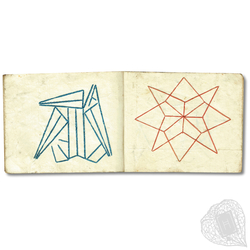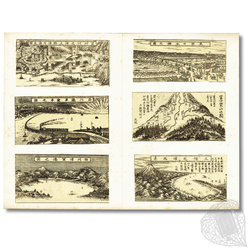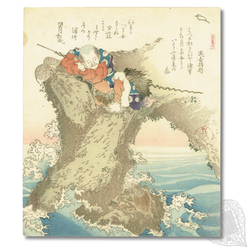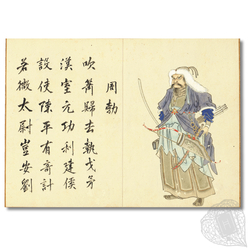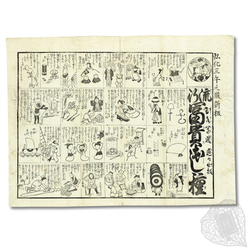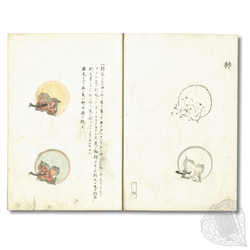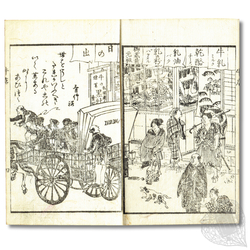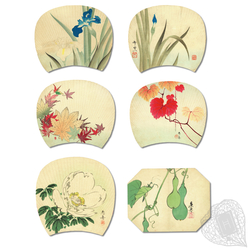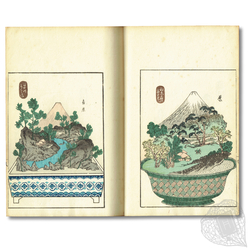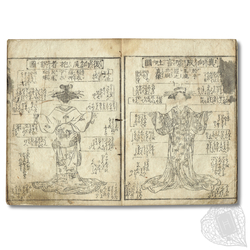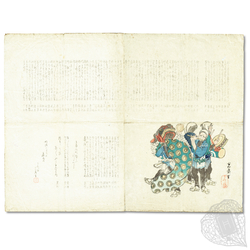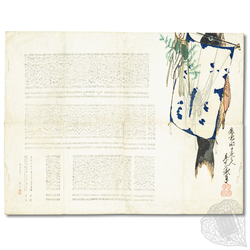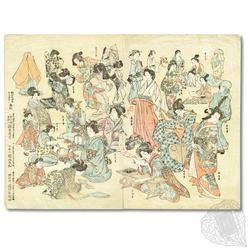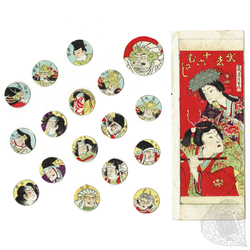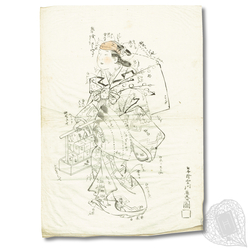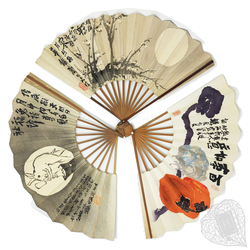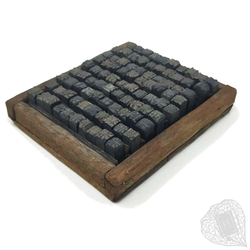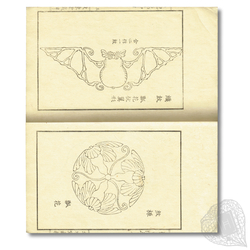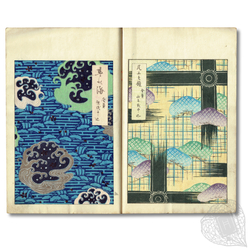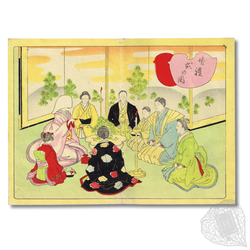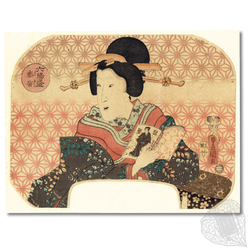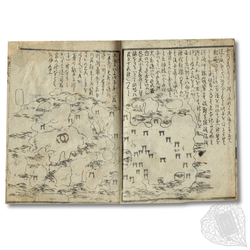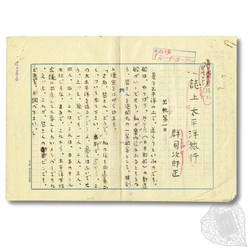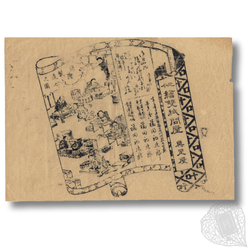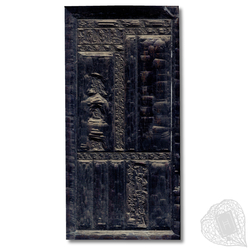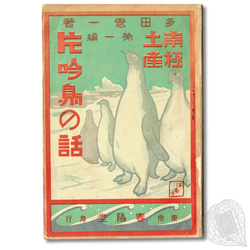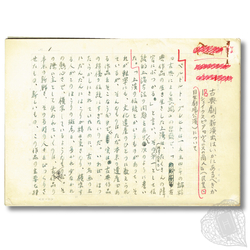Classic Illustrated Books Modern Art and Design Books Translations of Western Texts Japanese Literature Prints and Ephemera Western Books Photo Books Paintings & Scrolls Australia & New Zealand Others
Australia New Zealand Antarctica Japan Korea China Other
Edo Period [1603-1853] Bakumatsu Period [1853-1868] Meiji Period [1868-1912] Taishō Period [1912-1926] Shōwa Period [1926-1989]
Share this book on...

NEW ARRIVALS
| 1 - 50 of 20 : |
Nankyoku Tairiku (The Antarctic Continent)
Nankyoku Tairiku [The Antarctic Continent]
Nihon Kyokuchi Kenkyū Shinkōkai [edited by].
Tōkyō: Nihon Kyokuchi Kenkyū Shinkōkai, 1965.
A sizeable (79 x 109.5 cm) colour map of Antarctica edited and produced by the Japan Polar Research Association (J.P.R.A.) in 1965. The map has a scale of 1:6,500,000, and place names are recorded in English and occasional ...
Nankyoku Tairiku (The Antarctic Continent)
Nankyoku Tairiku [The Antarctic Continent]
Tada, Fumio [proofread by].
Tōkyō: Chiseisha, [ca. 1957-1958].
A large (115 x 109 cm) colour map of Antarctica produced in commemoration of the International Geophysical Year (also known as the IGY, 1957-1958). Professor Tada Fumio (1900-1978), who proofread the map, was a central figure in organising Japan's ...
Nankyoku Tanken Jitsuroku (True Record of the Antarctic Expedition)
Nankyoku Tanken Jitsuroku [True Record of the Antarctic Expedition]
Tada, Keiichi [text by].
Tōkyō: Kainan Shuppan Kyōkai, Shōwa 31 [1956]. First edition.
A record of Japan's first Antarctic expedition (1910-1912) by the expedition's secretary and, later, assistant naturalist Tada Keiichi (1883-1959), following earlier works including his personal, ...
Nankyoku Tanken Inuzori-tai: Futari no Ainu no Hanashi (Antarctic Expedition Dog Sled Team: The Story of Two Ainu People)
Nankyoku Tanken Inuzori-tai: Futari no Ainu no Hanashi [Antarctic Expedition Dog Sled Team: The Story of Two Ainu People]
Koide, Shōgo [text by].
Tōkyō: Fuzanbō, Shōwa 20 [1945]. First edition.
The story of the two Ainu men, Yayomanekuh (Yamabe Yasunosuke, 1867-1923) and Sisratoka (Hanamori Shinkichi, b. 1875/1876- year of death unknown), who travelled as ...
Watashi no Nankyoku Tanken-ki (My Account of the Antarctic Expedition)
Watashi no Nankyoku Tanken-ki [My Account of the Antarctic Expedition]
Shirase, Nobu [text by].
Tōkyō: Kōkoku Seinen Kyōiku Kyōkai, Shōwa 18 [1943]. Third edition.
A re-titled and re-packaged edition of Shirase Nobu's Nankyoku Tanken published during wartime. This copy is from the third edition, printed less than six months after the first edition ...
Nankyoku he Itta Neko no Hanashi (The Tale of the Cat who Went to Antarctica)
Nankyoku he Itta Neko no Hanashi [The Tale of the Cat who Went to Antarctica]
Koide, Shōgo [adapted by]; Watabe, Kikuji [binding designed by]; [Carroll, Ruth (illustrated by)].
Tōkyō: Dōwa Shunjūsha, Shōwa 17 [1942]. First edition.
An adaptation of Ruth and Latrobe Carroll's Luck of the Roll and Go (first published New York: Macmillan Co., 1935). The ...
Shirase Chūi Tanken-ki (An Account of Lieutenant Shirase's Expeditions)
Shirase Chūi Tanken-ki [An Account of Lieutenant Shirase's Expeditions]
Taniguchi, Zenya, Kimura, Yoshimasa [text by].
Tōkyō: Daichisha, Shōwa 17 [1942]. First trade edition.
The first trade edition of Shirase's biography, published two years after the extremely scarce first edition. The authors, Taniguchi Zenya (1916-2011) and Kimura Yoshimasa ...
Nankyoku Tanken (Expedition to Antarctica)
Nankyoku Tanken [Expedition to Antarctica]
Shirase, Nobu [text by].
Tōkyō: Hakubunkan, Taishō 2 [1913]. Third edition.
A third edition of the personal account of Japan's first Antarctic expedition (1910-1912) recorded by the expedition's leader, Japanese Army Lieutenant Shirase Nobu (1861–1946). Shirase's crew departed Tokyo on the Kainan ...
Nankyoku Tanken Shiroku (A Personal Account of the Antarctic Expedition)
Nankyoku Tanken Shiroku [A Personal Account of the Antarctic Expedition]
Tada, Keiichi [text by].
Tōkyō: Keiseisha, Taishō Gannen [1912]. Fourth edition.
A personal, unauthorised, account of Japan's first Antarctic expedition (1910 1912) by the expedition's secretary and, later, assistant naturalist Tada Keiichi (1883-1959). The work includes nine ...
Untitled album of tipped-in photographs of the San Francisco Japanese Tea Garden
[Untitled album of tipped-in photographs of the San Francisco Japanese Tea Garden]
[Hagiwara, Gorō (compiled by?)].
[San Francisco, ca. 1930s].
An album containing sixteen large tipped-in monochrome photographs captured around the 1930s of the Japanese Tea Garden in San Francisco. The verso of the upper wrapper of the album bears the signat ...
Natsu-matsuri Ikiji no Edokko (Summer Festival Spirit of the Edoites)
Natsu-matsuri Ikiji no Edokko [Summer Festival Spirit of the Edoites]
[Utagawa], Toyokuni [III] [illustrated by].
[Edo (Tōkyō)]: [Ōta] Takichi, [1858].
The rōnin Issun Tokubē (left) fights fishmonger (and accidental murderer) Danshichi Kurobē (right) in this dramatic scene from the kabuki Natsu Matsuri Naniwa Kagami illustrated by Utagawa Kunisada I ...
Kyōji Kozaiku no E, Oteasobi Mono Shinajina (Stationer's Goods for Intricate Handiwork, Playthings, and so on)
Kyōji Kozaiku no E, Oteasobi Mono Shinajina [Stationer's Goods for Intricate Handiwork, Playthings, and so on]
Kyōjiya Hikobē-ten [produced by].
Kyōto: Kyōjiya Hikobē-ten, [ca. late Edo period (1800-50s?)].
An advertisement for goods produced by a kyōjiya - a specialist in mounting hanging scrolls and installing interior screens but also, as thi ...
Shinpan Kuchikara Dehaudai Oshiegusa (Teachings on Whatever Comes to Mind, Newly Produced)
Shinpan Kuchikara Dehaudai Oshiegusa [Teachings on Whatever Comes to Mind, Newly Produced]
Hyakunokuchi, [Nukemaru?] [edited by].
Kyōto: Akitaya Tōroku, [ca. Tenpo period (1830-1845)?].
A comical print recording a wave of unsolicited advice ("teachings") on men and women from a rambling author, pictured yawning on the right. In the lower section of t ...
Kokkei Ana-sagashi (Funny Flaw-Finding)
Kokkei Ana-sagashi [Funny Flaw-Finding]
[Utagawa], Yoshimori [illustrated by].
[Tōkyō]: Iseshō [Iseya Shōnosuke], [1864].
A comical woodblock print by Utagawa Yoshimori (1830-1885), introducing seven character flaws across two scenes. The nishiki-e, number five of an indeterminate number of prints in Yoshimori's Kokkei Ana-sagashi series, describes ch ...
Untitled book of hand-sewn amulets
[Untitled book of hand-sewn amulets]
[Creator unidentified].
[Japan, ca. late Edo period (1800-60s?)].
A small but lovingly assembled book of 25 hand-sewn semamori designs. Semamori or semon ("back crests" or "back-protectors") are designs traditionally sewn into children's kimono to prevent the soul from leaving the body or evil spirits from att ...
Untitled album of copperplate-printed illustrations
[Untitled album of copperplate-printed illustrations]
[Compiler unidentified].
[Japan: publisher/s unidentified, ca. late Meiji period (1905-1915?)].
An album of 86 tipped-in copperplate-printed illustrations of famous locations around Japan. Many of the landscapes, among them Mt. Fuji, Kamakura, and Nara, are provided with captions and rendered ...
Untitled surimono depicting Urashima Tarō and a turtle
[Untitled surimono depicting Urashima Tarō and a turtle]
Yanagawa, [Shigenobu] [illustrated by].
[Japan: publisher unidentified, ca. late Meiji to Taishō period (1890-1920s)?].
A Meiji to Taishō-era printing of this shikishi-ban surimono illustrated by Yanagawa Shigenobu (1787-1832), one of Katsushika Hokusai's pupils. The charming woodblock print, pa ...
Untitled set of albums depicting military figures from Chinese history
[Untitled set of albums depicting military figures from Chinese history]
[Creator unidentified].
[Japan, ca. late Edo period (1800-1850s?)]. In manuscript.
A set of two manuscript albums containing portraits and brief biographies of thirty-six military generals, military strategists, or politicians from Chinese history. Some of the figures included are ...
Ryūkō Fukitashi-kusa (Modish Seeds of the Sayings of the Wealthy and Arrogant)
Ryūkō Fukitashi-kusa [Modish Seeds of the Sayings of the Wealthy and Arrogant]
Gyokusui, En [or Gyokusuien] [selections by]; [artist unidentified].
[Japan: publisher unidentified], Kōka 3 [1846].
A bizarre woodblock-printed compilation of single-frame giga (cartoons), featuring visual puns, nazonazo puzzles, and tricky wordplay often requiring knowledg ...
Tōga Hitorigeiko (Modern Illustration for Solo Study)
Tōga Hitorigeiko [Modern Illustration for Solo Study]
[Kijakusai (?) (preface by)].
Fushimi: Kameya Hanbē, Kōka 5 [1848].
A "teach yourself painting" book for beginners, featuring information on topics including the necessary pigments and implements, the different grips for brushes, the effects given by different brush types and strokes, the correct or ...
Ushiya Zōdan Aguranabe: Ichimei Doronken (Beef-Shop Small-Talk: Cross-Legged (at a Beef) Pot)
Ushiya Zōdan Aguranabe: Ichimei Doronken [Beef-Shop Small-Talk:Cross-Legged (at a Beef) Pot]
Kanagaki, Robun [text by]; Ikkeisai [Utagawa], Yoshiiku [illustrated by].
Tōkyō: Wan'ya Kihee, [preface dated Meiji 4 (1871)].
The first two series (of three) of Robun's famous satire on the perceived sophistication of Western customs. In the work, he ridic ...
Untitled collection of six uchiwa-e
[Untitled collection of six uchiwa-e]
Suzuki, Kiitsu, [Shibata], Zeshin, [Takahashi], Ōshin [illustrated by].
[Japan: publisher unidentified, ca. late Edo to early Meiji period (1850-70s?)].
A collection of six woodblock-printed uchiwa-e (fan prints) featuring seasonal plants and flowers including irises, maple leaves, and gourds. The prints featuring iris ...
Sumiyoshi Monogatari (The Tale of Sumiyoshi)
[Sumiyoshi Monogatari (The Tale of Sumiyoshi)]
[Scribe and illustrator unidentified].
[Japan, ca. early Edo period (1600-1750s?)]. In manuscript.
An opulent Nara ehon (Nara picture book) manuscript of the first volume of Sumiyoshi monogatari. The tale is a giko monogatari — a story featuring Heian period aristocrats — and follows the ...
Dai-shin-kufū Zenmai Mawari Kage Tōrō (Grand New Ingenuity: A Spring-Wound Shadow Lantern)
Dai-shin-kufū Zenmai Mawari Kage Tōrō [Grand New Ingenuity: A Spring-Wound Shadow Lantern]
[Creator unidentified].
Horikawa, [Kyōto]: Wakuji, [ca. late Edo period to early Meiji period (1850-70s?)].
An instruction sheet for building a karakuri ningyō - a doll or puppet designed to move using a mechanism but appear as if it is moving independen ...
Draft illustrations for Onna Irezumi-shi (The Woman Tattoo Artist)
[Draft illustrations for Onna Irezumi-shi ("The Woman Tattoo Artist")]
[Shimizu, Miezō (illustrated by)].
[Japan, ca. Shōwa 25 (1950)]. In manuscript.
A set of 190 draft illustrations by Shimizu Miezō (1893-1962) for the serial novel Onna Irezumi-shi ("The Woman Tattoo Artist") by Kunieda Kanji (1892-1956). The serial ran across 201 issues of the Sangyō Ke ...
Tōkaidō Gojūsantsugi Hachiyama-zue (Pictures of the Fifty-three Stations of the Tōkaidō as Potted Mountains)
Tōkaidō Gojūsantsugi Hachiyama-zue ["Pictures of the Fifty-three Stations of the Tōkaidō as Potted Mountains"]
Kimura, Tōsen [produced by]; Nan'yūtei [Utagawa, Yoshishige] [illustrated by].
Tōto [Edo]: Yoshida Kinbē, Kaei Gannen [1848] [but probably a Meiji era printing].
This inventive work offers a tour along the Tōkaidō hi ...
Jūshi Keisei Hara-no-uchi (Inside the Guts of Fourteen Bombshell Beauties)
Jūshi Keisei Hara-no-uchi ["Inside the Guts of Fourteen Bombshell Beauties"]
Shiba, Zenkō [text by]; [Kitao, Shigemasa (illustrated by)].
[Tōri Abura-chō (Edo): Senkakudō, Kansei 5 (1793)].
A scarce medical-themed kibyōshi with eye-catching illustrations by Kitao Shigemasa. The description below of the work is provided by Hisa Kuriyama in Compara ...
Untitled surimono
[Untitled surimono]
Kōsai [Utagawa, Yoshimori] [illustrated by].
[Japan: privately published], Meiji 2 [1869].
A haikai surimono featuring an illustration of a shishimai lion dancer and three musicians by Utagawa Yoshimori (1830-1885), a pupil of Kuniyoshi. The texture of the brush strokes from Yoshimori's original illustration has been masterful ...
Untitled surimono
[Untitled surimono]
[Shibata], Zeshin [illustrated by]; Baiso [statement of responsibility by].
[Japan: privately published], Kinoene [1864].
A haikai surimono featuring an illustration of a kite, fish, pine, and what may be paper shide by Shibata Zeshin (1807-1891). The name Baiso appears under the date (spring, 1864) at the end of the text and prob ...
Untitled compilation of illustrations of beautiful women by famous artists
[Untitled compilation of illustrations of beautiful women by famous artists]
Inaba, Keikichi [edited by].
Tōkyō: Tsūshin Shinbunsha, Meiji 24 [1891].
A woodblock-printed compilation of illustrations of beautiful women from famous artists including (but not limited to) Toyokuni, Kuniyoshi, Hiroshige, Hokusai, Utamaro, Eisen, Tsunenobu, Yoshitada, Kōsen, Mo ...
Musha Jūroku Musashi (A Jūroku Musashi Game of Warriors)
Musha Jūroku Musashi ["A Jūroku Musashi Game of Warriors"]
Ōsai [Utagawa], Fusatane [illustrated by].
Bakurochō, [Tōkyō]: Higuchi Gintarō, [ca. Meiji period (1880-90s?)].
A variation on a classic Japanese strategy game, Jūroku Musashi ("Sixteen Soldiers"). In the game, which is believed to have originated in the Edo period, two players first decide who ...
A collection of practice paintings by a student artist
[A collection of practice paintings by a student artist]
[Illustrator unidentified].
[Japan, ca. Meiji period (1870-90s?)]. In manuscript.
A collection of 29 leaves of paintings of animals and people produced by a burgeoning artist for practice. The paintings are largely copied from artworks by notable artists including Miyagawa Chōshun (1682-1752) and Iwa ...
A collection of 39 fans
[A collection of 39 fans]
Kamisaka, Sekka, Tomioka, Tessai, Takeuchi, Seihō .. [et al.] [illustrated by].
[Kyōto?: publisher/s unidentified, ca. late Meiji to early Shōwa period (1910-1920s?)].
A beautifully preserved collection of 39 eye-catching sensu fans featuring designs based on fruits, flowers, landscapes, people, and animals, by acclaimed artists i ...
Bijutsukai (Sea of Art)
Bijutsukai ["Sea of Art"]
Yamada, Naosaburō [produced by]; Furuya, Kōrin, Kaigai, Tennen, Kamisaka, Sekka ... [et al.] [illustrated by].
Kyōto: Yamada Unsōdō, Meiji 32-38 [1899-1905].
Issues 31-40, 58, 59, 61, 62, and 63 (of 70) of the acclaimed zuan magazine Bijutsukai. Replete with stunning colour woodblock-printed designs for textiles (and occasionally ...
Untitled set of printing blocks
[Untitled set of printing blocks]
[Creators unidentified].
[Japan, ca. late Edo to early Shōwa period (1860-1930s?)].
An assortment of wooden and metal printing blocks and pieces of type produced in Japan. Most of the wooden blocks feature advertisements for sake and hemp, and seem to have been produced in Yashū, Tochigi Prefecture. The metal blocks, on t ...
A small set of movable type
[Set of movable type]
[Creator unidentified].
[Japan, ca. Meiji period (1870-90s?)].
A small set of hand-cut wooden movable type, probably produced in the Meiji period. The faces of the ninety pieces measure approximately 6 x 6 mm, and all depict kanji characters. The wooden tray is thought to be original. The type was probably used to print books or ...
Shin'an Ishō Chikosakura (Chigozakura: New Designs)
Shin'an Ishō Chikosakura ["Chigozakura: New Designs"]
Tanaka, Jihē [edited by].
Kyōto: Tanaka Jihē, Meiji 23 [1890].
Volume one, believed to be all published, of this little-known album of creative designs for embroidery, brush cases, vases, inkstones, weights for hanging scrolls, and other objects. The preface notes that the work was published to s ...
Bankoku Meisho-zue: Sekai Ryokō = Illustrated Guide Book for Travellers Round the World
Bankoku Meisho-zue: Sekai Ryokō = Illustrated Guide Book for Travellers Round the World
Aoki, Tsunesaburō [edited by].
Ōsaka: Aoki Tsunesaburō, Meiji 18-19 [1885-1886].
A seven-volume set of copperplate-printed guidebooks for countries around the world. While the books focus on famous landmarks and iconic locations, information on and illustrations of hist ...
Ishō Sekai (World of Designs)
Ishō Sekai ["World of Designs"]
[Sawa], Kyūkō ... [et al.] [illustrated by]; Watanabe, Takijirō [woodblocks cut by].
Tōkyō: Seibikai, Meiji 34 [1901].
Issue 5 of the magazine Ishō Sekai, published by the Seibikai ("The Exquisite Beauty Association"). The eighteen textile designs included were provided by members of the Seibikai, and the woodblocks were cu ...
Seiyō Jiki Teikokuhan (Model of Western Time Measurements)
[Seiyō Jiki Teikokuhan ("Model of Western Time Measurements")]
[Kanshūtei (preface by)].
[Tōto (Tōkyō): publisher unidentified, ca. early to mid-Meiji period (1870-1890s)].
A small volume providing Western equivalents of Japanese time measurements. The names of daytime measurements (e.g. "the time of the snake") are printed in red, while those of nighttim ...
Joreishiki no Zu (Illustrations of Ladies' Etiquette)
Joreishiki no Zu ["Illustrations of Ladies' Etiquette"]
[Yasui], Kotō [illustrated by].
Nihonbashi, [Tōkyō]: Matsuno Yonejirō, Meiji 28 [1895].
A colour woodblock-printed album of scenes of elegant Japanese ladies engaging in traditionally appropriate pastimes and ceremonies. The fourteen scenes spread over eight leaves picture women exchanging N ...
Grand Concert Parisien, Rentree de Mme Bonnaire (...)
Grand Concert Parisien, Rentree de Mme Bonnaire [...]
[Concert Parisien (produced by)].
[Paris: Concert Parisien, 1890?].
A chirimen (crepe paper) poster advertising various acts at the Concert Parisien. One of the acts is the famous cafe performer Yvette Guilbert (1865-1944), who joined the Concert Parisien around 1889 after leaving the caf&ea ...
Muyōsei (The Six Personalities)
Muyōsei ["The Six Personalities"]
[Utagawa], Toyokuni [III] [illustrated by].
[Tōkyō: Ibasen, Kaei 6 (1853)].
A complete set of uchiwa-e (fan prints) illustrated by Kunisada I (Toyokuni III) for the publisher and fan shop Ibasen (founded 1590). Each beautiful woman in this series represents one of the six days from the traditional Japanese fortune-te ...
Bandō Shichi-eishi (The Seven Great Samurai of Bandō), Tenjin Shichidaiki (Record of the Seven Generations of the Age of the Gods), Taiheiki (Chronicle of Great Peace)
1.
Bandō Shichi-eishi ["The Seven Great Samurai of Bandō"]
Jippensha, Ikku [text by]; Katsukawa, Shuntei [illustrated by].
[Edo?: Enomotoya Kichibē, preface dated Kansei 13 (1801)].
An incomplete copy of this little-known work by the famous author Jippensha Ikku (1765-1831). The leaves are numbered 5, 2, 3, 5, 6, 7, 8, 9, 10. The first leaf ( ...
Shijō Taiheiyō Ryokō (A Trip to the Pacific on Paper)
Shijō Taiheiyō Ryokō ["A Trip to the Pacific on Paper"]
Gunji, Jirōmasa [handwritten by].
[Japan, ca. early to mid-Shōwa period (1940-1950s?)]. In manuscript.
A draft of an article for All Women (Ōru Josei) magazine handwritten by author and lyricist Gunji Jirōmasa (1905-1973). In the article, the author takes the role of a guide, leading the readers (whic ...
Four single-leaf advertisements
[Four single-leaf advertisements]
Saitō, Moemon ... [et al.] [text by]; [Kobayashi], Kiyochika ... [et al.] [illustrations by].
[Japan: Kitagawaya, Gusokuya, ca. late Meiji period (1880-1900s)?].
A set of hikifuda (advertisements) produced for the bookseller Kitagawaya (Saitō Moemon) and the jihon doiya Gusokuya Kahei. The single print produced for Gusoku ...
Shukka Hōkoku (Shipping Report)
Shukka Hōkoku ["Shipping Report"]
[Tomimura Naokichi Shōten (commissioned by)].
Tōkyō: Tomimura Naokichi Shōten, [ca. Meiji period (1870-90s?)].
A woodblock used at the Nihonbashi-based firm Tomimura Naokichi Shōten to print shipping forms. Although illegible, the item being sent (possibly a gathering of fabric) must have been shipped often by the compa ...
Title unidentified
[Title unidentified]
[Artist unidentified].
[Tōkyō: Chūō Hyōron-sha, ca. mid-Shōwa period (1950-60s?)].
A small printing block for a strip comic that probably appeared in a publication by the Chuō Hyōron-sha (the Chuo University Review), as this company name is inscribed on the side of the block. The strip seems to show a man being thrown out of an o ...
Pengin-chō no Hanashi (The Story of Penguins)
Pengin-chō no Hanashi ["The Story of Penguins"]
Tada, Keiichi [written by]; Tada, Haruki [illustrated by].
Tōkyō: Shunyōdō, Taishō Gannen [1912].
An introduction to penguins, written and illustrated by Tada Keiichi (Tada Haruki, 1883-1959). Tada travelled to the South Pole with Shirase Nobu in 1910 as the expedition's secretary/record keeper. The te ...
Kotengeki no Shinenshutsu wa Ikani Arubekika: Sheikusupia 'Uenisu no Shōnin' (Mingei, Nissei Gekijo Kōen) ni Tsuite (How Should New Productions of Classic Plays be Staged? Shakespeare's The Merchant of Venice (Mingei and Nissei Theatre Product
Kotengeki no Shinenshutsu wa Ikani Arubekika: Sheikusupia "Uenisu no Shōnin" (Mingei, Nissei Gekijo Kōen) ni Tsuite ["How Should New Productions of Classic Plays be Staged? Shakespeare's The Merchant of Venice (Mingei and Nissei Theatre Productions)"]
Takei, Teruo [written by].
[Japan, ca. 1968]. Handwritten.
A draft in pen of an article by famed lit ...
| 1 - 50 of 20 : |
Classic Illustrated Books Modern Art and Design Books Translations of Western Texts Japanese Literature Prints and Ephemera Western Books Photo Books Paintings & Scrolls Australia & New Zealand Others
Australia New Zealand Antarctica Japan Korea China Other
Edo Period [1603-1853] Bakumatsu Period [1853-1868] Meiji Period [1868-1912] Taishō Period [1912-1926] Shōwa Period [1926-1989]
Share this book on...







